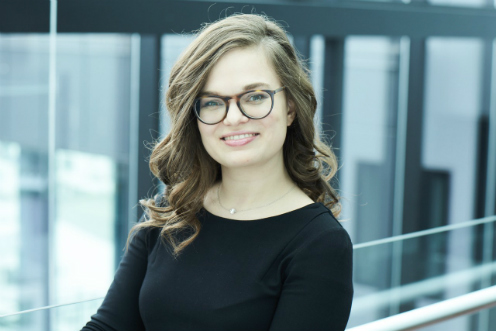Research Talent: Artists and researchers see the world from new angles
As a youth, Kirsten Marie Ørnsbjerg Jensen imagined studying art history or playing classical music. She ended up in the field of chemistry, working with atomic structures and nanomaterials. But for her, there isn’t much of a difference between art and natural science. New perspectives and fresh thinking are important in both worlds. Ørnsbjerg Jensen has just been honoured with the "International Rising Talent" award, presented by L’Oréal and UNESCO.

It isn’t just in film, music and literature that creativity and innovation blossom and bear fruit. The natural sciences require creative new approaches as well. Especially if we hope to solve the major problems confronting us, including climate change and the need for green energy to replace nonrenewable, polluting fossil fuels.
Kirsten Marie Ørnsbjerg Jensen, a 33-year-old chemist and nano-researcher at the University of Copenhagen's Department of Chemistry is a prime example that creativity and innovation are constantly being unfurled and deployed in the natural sciences.
"From a very early age, I had lots of plans about what I wanted to be. This included studying art history or playing classical music. But thanks to the talented chemistry and physics teachers at my elementary school and Rosborg High School in Vejle, I developed a keen interest for chemistry and the natural sciences. Fortunately, chemistry continues to fascinate me. By understanding the world at the atomic level, we can design new molecules and materials to help us solve some of the challenges facing our world. My job is to dive into the atomic structures of new nanomaterials. To be a scientific researcher and gain deeper insight into the world requires logical thinking, but likewise, creativity. We must always consider how we might appreciate the world from new angles. Thus, I don’t see any great difference between art and the sciences, in terms of thinking anew and differently," says Kirsten Marie Ørnsbjerg Jensen.
Fifteen award recipients worldwide
Jensen is among fifteen young women researchers in the natural sciences being presented with the "International Rising Talent" award. The prize was presented by French cosmetics company L‘Oréal, and UNESCO, the UN organization for education, science and culture. Kirsten Marie Ørnsbjerg Jensen will be presented with the 15,000 Euro award on March 14 at UNESCO's Paris headquarters. The evaluation committee selected the 15 laureates from a list of participants from 117 countries, all of whom had already been awarded L’Oréal-UNESCO awards at national levels. Kirsten Marie Ørnsbjerg Jensen received the Danish award in 2017. Now she has been named as a top international woman researcher.
"I'm happy and tremendously proud of the award. It is a great encouragement in my everyday life as a researcher.
I conduct basic research. In my group, we study the basic processes that occur when materials are developed. Our goal is to gain a new understanding of the atomic structures in nanomaterials. This type of research can lay a foundation for the development of new materials. For example, for batteries or catalysis, that will be used to create new green energy technologies. While we are definitely on the research side of things, something I like about materials research is that there is always a clear link to applied research and technological development, even though it can be a long road at times,” underscores Kirsten Marie Ørnsbjerg Jensen.
Materials by design
The 33-year-old assistant professor works in materials chemistry with what is known as the "Materials by Design" concept. It is an area of great significance for the development of new technologies and products that serve modern society. By understanding the relationships between atomic structures and the properties of materials, chemists can design and tailor new materials with beneficial properties across a wide range of applications, including for energy-related materials and batteries. Materials chemistry extends beyond traditional energy technologies. In recent years, many new materials have been developed with properties that solve a host of other problems. For example, one can find nano-materials that filter heat from windows while allowing light in during extremely hot and sunny weather. Kirsten Marie Ørnsbjerg Jensen’s research focuses on mapping atomic structure. She does so by using cutting edge x-ray and neutron scattering techniques, among other methods.
Follow the process
In recent years, nanoscience research has made it possible to manufacture nanomaterials with near atomic precision. This has allowed for the development of new technologies, including green energy technology. To take advantage of these new materials, knowing about the atomic structure of nanoparticles and their properties is vital. In addition to studying the structure of new materials, the young awardee and her research group have been able use so-called ‘time-resolved measurements’. This allows the group of researchers to follow the process and formation of new materials with customized properties for technological advances – in real time.
Kirsten Marie Ørnsbjerg Jensen is supported with large multi-million grants from the Villum Foundation’s Young Investigator Programme, ERC funds from the EU’s ERC Starting Grant programme and by other sources of funding. She is a graduate of the University of Aarhus and was a researcher at Columbia University in New York prior to being hired by the University of Copenhagen in 2015.
Related News
Contact
Kirsten Marie Ørnsbjerg Jensen, adjunkt
Department of Chemistry
University of Copenhagen
Mobil: +45 40 51 76 36
kirsten@chem.ku.dk
Journalist Svend Thaning
Mobil: +45 28754281
svt@science.ku.dk
